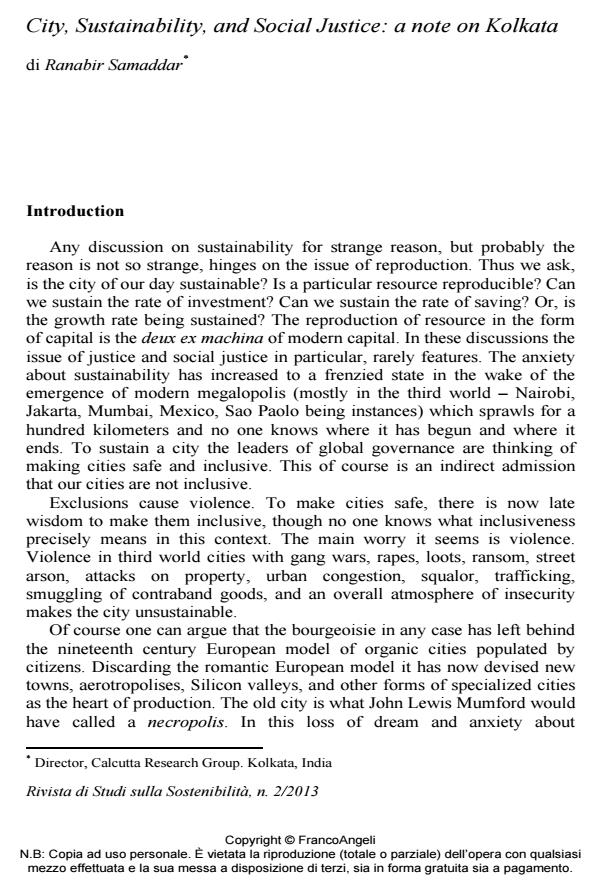City, Sustainability, and Social Justice: a note on Kolkata
Titolo Rivista RIVISTA DI STUDI SULLA SOSTENIBILITA'
Autori/Curatori Ranabir Samaddar
Anno di pubblicazione 2014 Fascicolo 2013/2 Lingua Inglese
Numero pagine 15 P. 129-143 Dimensione file 630 KB
DOI 10.3280/RISS2013-002007
Il DOI è il codice a barre della proprietà intellettuale: per saperne di più
clicca qui
Qui sotto puoi vedere in anteprima la prima pagina di questo articolo.
Se questo articolo ti interessa, lo puoi acquistare (e scaricare in formato pdf) seguendo le facili indicazioni per acquistare il download credit. Acquista Download Credits per scaricare questo Articolo in formato PDF

FrancoAngeli è membro della Publishers International Linking Association, Inc (PILA)associazione indipendente e non profit per facilitare (attraverso i servizi tecnologici implementati da CrossRef.org) l’accesso degli studiosi ai contenuti digitali nelle pubblicazioni professionali e scientifiche
This article offers some reflections on sustainability in Kolkata, Indian city characterized by a steady increase in population, poverty and violence. It is argued that the key issue is not the continuous increase in population, but how to square the circle between, on the one hand, social justice and the right at a decent standard of living and, on the other, environmental sustainability and the availability of resources.
Questo articolo si occupa della questione di sostenibilità in Kolkata, città indiana caratterizzata da un costante aumento di popolazione, violenza e povertà. Si sostiene che la questione fondamentale non è l’aumento continuo della popolazione, ma come far quadrare il cerchio tra giustizia sociale e diritto a un livello di vita decente, da un lato e, dall’altro la sostenibilità ambientale e la disponibilità di risorse.
Keywords:Kolkata, giustizia sociale, violenza, diseguaglianza, risorse
- Appadurai A. (2001). Deep Democracy: Urban Governmentality and the Horizon of Politics. Environment and Urbanisation, 13(2): 23-43, DOI: 10.1177/095624780101300203
- Bandyopadhyay R. (2007). From Public to Pablik: Elementary Aspects of Street Politics in Postcolonial Calcutta. Journal of the Indian Anthropology, 42, 3.
- Basu M. (1985). Anthropological Profile of Muslims of Calcutta. Anthropological Survey of India, Calcutta
- Benjamin W. (2002). The Arcades Project (ed. R. Tiedemann). Cambridge, MA: Belknap Press of Harvard University Press.
- Chatterjee P.K. (1991). Struggle and Strife in Urban Bengal, 1937-1947. Calcutta, Das Gupta.
- Connery R.H. (ed) (1968). Urban Riots: Violence and Social Change, Proceedings of the Academy of Political Science, 29, I, New York.
- Das S. and Bandyopadhyay P. (2004). Food Movement of 1959: Documenting a Turning Point in the History of West Bengal. K.P. Bagchi, Kolkata.
- Das S. (2000). The 1992 Calcutta Riot in Historical Continuum: A Relapse into ‘Communal Fury’?. Modern Asian Studies, 34, 2, May, DOI: 10.1017/S0026749X0000336X.
- Das S. (1991). Communal Riots in Bengal 1905-1947. Delhi: Oxford University Press.
- Desai and Sanyal (ed.) (2011). Urbanising Citizenship: Perspectives on Contested Spaces in Indian Cities. New Delhi: Sage.
- Desai R. (2012). Governing the Urban poor: Riverfront Development, Slum Resettlement and the Politics of Inclusion in Ahmedabad, XLVII, 02, January 14,
- Grappi G. (2013). Calcutta as a Site for Extraction, unpublished paper, mimeo.
- Guha Roy S. (1990). Fare Hike and Urban Protest: Calcutta Crowd in 1953. Economic and Political Weekly, XXV, 52, Dec.
- Haan A. de. (1997). Unsettled Settlers: Migrant Workers and Industrial Capitalism in Calcutta. Modern Asian Studies, 31, 4: 919-949 Oct.
- Hansen T.B. (2002). Violence in Urban India: Identity Politics, ‘Mumbai’ and the Post-Colonial City. Hyderabad: Orient Blackswa.
- Harvey D. (2009). Social Justice and the City. University of Georgia Press, (Revised Edition).
- Harvey D. (1989). The Urban Experience. Baltimore: The John Hopkins University Press.
- Racine J. (ed) (1990). Calcutta 1981: The City, Its Crisis, and the Debate on Urban Planning and Development. South Asia Books.
- Ramaswamy V. (2008). Basti Redevelopment in Kolkata. Economic and Political Weekly, XLIII, 38, Sept 20.
- Sengupta D. (2006). A City Feeding on Itself: Testimonies and Histories of ‘Direct Action’ Day. In: Sarai Reader. Delhi: CSDS.
- Shaw A. (1999). The Planning and Development of New Bombay. Modern Asian Studies, 33, 4: 951-988, DOI: 10.1017/S0026749X99003534
- Shaw A. (ed.) (2007). Indian Cities in Transition. Hyderabad: Orient Blackswan.
- Thomas F.C. (1997). Calcutta Poor: Elegies on a City above Pretense, New York and London: M.E. Sharpe.
- Tilly C. (1999). Durable Inequality. Berkeley: University of California Press.
- Tilly C. (2003). The politics of collective violence. Cambridge: Cambridge University Press.
- Tilly C. (2006). Regimes and Repertoires. Chicago: University of Chicago Press, DOI: 10.7208/chicago/9780226803531.001.0001
- Webster R. (2011). The Street Belongs to Us! The Autonomous Worlds of Street Children of Colaba, Mumbai, India. Asia Pacific Journal of Anthropology, 12, 5, DOI: 10.1080/14442213.2011.611162
- Weiner M. (1961). Violence and Politics in Calcutta. The Journal of Asian Studies, 20, 3, May, DOI: 10.2307/2050815
Ranabir Samaddar, City, Sustainability, and Social Justice: a note on Kolkata in "RIVISTA DI STUDI SULLA SOSTENIBILITA'" 2/2013, pp 129-143, DOI: 10.3280/RISS2013-002007